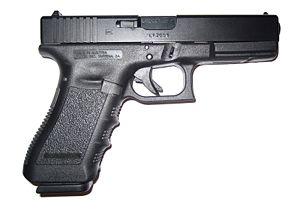Glock pistol
| Glock | |
|---|---|
 The Glock 17 (recent production model) |
|
| Type | Semi-automatic pistol |
| Place of origin | |
| Service history | |
| In service | 1980–present |
| Used by | See Users |
| Production history | |
| Designer | Gaston Glock |
| Designed | 1980 |
| Manufacturer | Glock GmbH |
| Produced | 1980–present |
| Variants | See Variants |
| Specifications | |
| Cartridge | 9x19mm Parabellum 10mm Auto .45 ACP .40 S&W .380 ACP .357 SIG .45 GAP |
| Action | Short recoil operated, locked breech, tilting barrel (straight blowback for .380 ACP variants) |
| Feed system | Box magazine, see Variants for capacities |
| Sights | Fixed, adjustable, and illuminated night notch sights |
Glock is the name of a family of semi-automatic pistols designed and produced by the Austrian company Glock GmbH from Deutsch-Wagram, founded in 1963 by engineer Gaston Glock to manufacture high-strength synthetic and steel components.
Contents |
Development
In May 1980, the company was invited to bid on a contract to supply the Austrian military with a new duty pistol to replace the World War II-era Walther P38 service pistol. Samples were submitted for assessment trials and, after passing all of the exhaustive endurance and abuse tests, Glock emerged as the winner with the Glock 17 model. The handgun was adopted into service with the Austrian military and police forces in 1982 as the P80 (Pistole 80).[1] Shortly thereafter, the weapon was accepted into service with the Dutch, Norwegian and Swedish armed forces. The Glock 17 gave rise to a range of modified versions with alternative caliber chamberings, external dimensions and weights, all retaining the basic design elements. By 1992, some 350,000 pistols had been sold in more than 45 countries, including 250,000 in the United States.
Design details
The Glock 17 (so named because it was the 17th patent of the company)[1] is a 9 mm semi-automatic pistol that uses a modified Browning locked breech short recoil operating principle.[2] The firearm’s locking mechanism has a vertically tilting barrel with a rectangular breech that engages a guide in the slide, on the breech face and a cut in the top front of the ejection port. The barrel recoils rearward, locked together with the slide approximately 3 mm (0.1 in) until the bullet leaves the barrel and pressure drops to a safe level. A ramped lug at the bottom of the barrel then engages an angled locking block in the frame, tilting the barrel downward while the slide continues back in a straight line.
The slide features a spring-loaded claw extractor and the stamped sheet-metal ejector is pinned to the subframe.[1] The striker firing mechanism has a spring-loaded firing pin that is cocked in two stages, powered by the firing pin spring. When the weapon is charged, the firing pin is in the half-cock position. As the trigger is pulled, the striker is fully cocked. At the end of its travel, the trigger bar is tilted downward by the disconnector, releasing the striker to fire the cartridge. The disconnector also resets the trigger bar so that the striker will be captured in half-cock at the end of the firing cycle. This is known as a pre-set trigger mechanism, referred to as the "Safe Action" trigger by the manufacturer. The disconnector also ensures the pistol can only fire in semi-automatic mode.
The Glock features a triple safety system that secures the weapon against accidental discharge and consists of three independent safety mechanisms: an external trigger safety[3] and two automatic internal safeties – a firing pin safety[4] and a drop safety.[5] The external safety is a small inner lever contained in the trigger. Pressing the lever activates the trigger bar and sheet metal connector. One of the internal safeties is a solid hardened steel pin which, in the secured state, blocks the firing pin channel (disabling the firing pin in its longitudinal axis). The firing pin safety is only pushed upward to release the firing pin for firing when the trigger is actuated and the safety is pushed up through the backward movement of the trigger bar, the second, drop safety guides the trigger bar in a precision safety ramp that is only released when a shot is triggered by pulling the trigger right back. The safeties are systematically disengaged one after another when the trigger is squeezed and then automatically re-activated when the trigger is released. This triple safety system guarantees safe handling of the pistol with a cartridge introduced into the chamber, reducing the time required to deploy the weapon. This allows the user to concentrate on tactical considerations, rather than manipulation of levers, hammers or external safeties found in other, conventional handguns.[1] However, in the case of a misfire this design provides no way to re-cock the striker without manipulating the slide and ejecting the dud round.
The Glock 17 feeds from a double-column box magazine with a 17-round capacity or an extended 19-round magazine. Magazines feature a steel body overmolded with plastic. A steel spring drives a plastic follower. After the last round has been fired, the slide remains open on the slide stop. The slide stop release lever is located on the left side of the frame directly beneath the slide and can be manipulated by the thumb of the shooting hand.
The Glock 17 has a fixed sight arrangement that consists of a ramped front sight and a notched rear sight with white contrast elements painted on for increased acquisition speed – a white dot on the front post and a rectangular border on the rear notch.[1] The rear sight can be adjusted for windage as it has a degree of lateral movement in the dovetail it is mounted in. Adjustable and illuminated night sights are also available.
The cold hammer-forged barrel has a polygonal (hexagonal) bore with a right-hand twist.[1] The weapon’s frame, magazine body and several other components are made from a high-strength nylon-based polymer. The frame also contains hardened steel guides molded into the internal surfaces. The slide is milled from a single block of ordnance-grade steel. The barrel and slide are finished with a proprietary nitriding process called Tenifer.
Current production Glock 17’s consist of 34 parts. For maintenance the pistol disassembles into five main groups: the barrel, slide, frame, magazine and recoil spring assembly.
The firearm is designed for the NATO-standard 9x19mm Parabellum pistol cartridge (bullet weight – 7.5 g, muzzle velocity – 350 m/s), but can also use high-power (increased pressure) +P and +P+ ammunition with either full metal jacket or jacketed hollow point projectiles.
The Glock was modernized several times throughout its production history. In 1991 a modified version of the recoil spring and recoil spring tube was introduced that is now a single integrated recoil spring assembly that does not disassemble. Additionally the magazine was slightly modified (the magazine floorplate was changed and the follower spring was fitted with a resistance insert at its base) and the trigger pull was increased (optionally). The factory standard trigger is rated at 25 N (5.6 lbf), but by using a modified connector it can be increased to 35 N (7.9 lbf). In response to a request made by American law enforcement agencies for a two-stage trigger Glock introduced the so-called NY (New York) trigger module, which features a flat spring in a plastic housing that replaces the trigger bar’s standard coil spring. This trigger upgrade is available in two versions: New York and New York Plus that are rated at 34 N (7.6 lbf) to 40 N (9.0 lbf) and 41 N (9.2 lbf) to 50 N (11.2 lbf) respectively, which require approximately 20 N (4.5 lbf) to 30 N (6.7 lbf) of force to disengage the safeties and another 10 N (2.2 lbf) in the second stage to fire a shot.
A mid-life upgrade to the Glock series involved the frame’s grip, which received checkering on the front strap and serrations to the rear (these pistols are sometimes called the generation 2 models). In the late 1990s the pistol’s frame was further modified with a Universal rail adapter (used to mount laser pointers and tactical flashlights), thumb rests on both sides of the frame and finger grooves on the front strap of the pistol grip (generation 3 upgrade). The extractor has also been changed twice and the locking block was enlarged along with the addition of another pin.[1]
The Glock pistol accessories include several devices for tactical illumination, such as front rail mounted lights with optional lasers and an adapter to mount a flashlight on the bottom of a magazine. Polymer holsters in various configurations and matching magazine pouches are also available. Glock also produces optional sights, triggers, recoil springs, slide stop levers, and underwater spring cups. Three open sight systems are produced.
In 2003, Glock announced the Internal Locking System (ILS) safety feature. The ILS is a manually activated lock that is located in the back of the pistol's grip. It is cylindrical in design and, according to Glock, each key is unique. When activated, the lock causes a tab to protrude from the rear of the grip giving both a visual and tactile indication as to whether the lock is engaged or not. When activated, the ILS renders the Glock unfireable as well as making it impossible to disassemble. When disengaged, the ILS adds no further safety mechanisms to the Glock pistol. The ILS is available as an option on most Glock pistols.
Variants
Following the introduction of the Glock 17, numerous variants and versions have been offered. Variants that differ in caliber, frame, and slide length are identified by different model numbers with the exception of the Glock 17L. Other changes not dealing with frame and slide length are identified with suffixes such as "C" which denotes compensated models. Minor options such as frame color, sights, and included accessories are identified by a separate model code on the box and do not appear anywhere on the firearm.
Glock pistols come in three main sizes, all modeled after the original full-size Glock 17. "Standard" full-size models are designed as duty weapons with a large magazine capacity. "Compact" models are a slightly smaller with reduced magazine capacity and lighter weight while maintaining a usable grip length. "Subcompact" models are designed for easier carry being lighter and shorter and are intended to be used with two fingers on the grip below the trigger guard. .45 ACP and 10 mm models are slightly larger than smaller cartridge pistols and are not offered in the 'compact' size. Glock produces a special single-stack "Slimline" .45 ACP pistol, the Glock 36. "Competition" versions have longer barrels and slides, adjustable sights, and extended slide and magazine release.
Some Glock pistols are available as "C" models (for "compensated") which have slots cut in the barrel and slide to reduce muzzle climb.[6]
- Glock 17C: Introduced in 1996 and incorporated slots cut in the barrel and slide to compensate for muzzle rise and recoil. Many other Glock pistols now come with this option, all with a "C" suffix on the slide.
- Glock 17L: Introduced in 1988 and incorporates a longer slide and extended barrel. Initially the 17L had three holes in the top of the barrel and a corresponding slot in the slide, however later production pistols lack the holes in the barrel. The Glock 17L is effectively discontinued, with the exception of very limited production runs.
- Glock 17A: Variant produced with a 120 mm (4.7 in) extended barrel that protrudes from the slide visibly. It is intended for the Australian market to conform to local laws regarding barrel length created after the Monash University shooting and are supplied with 10-round magazines.[7][8]
- Glock 17S: Glock 17 variant with an external, frame-mounted, manual safety. Small numbers of this variant were made for the Tasmanian, Israeli, Pakistani and perhaps several South American security forces.[9][10][11] They are stamped "17", not "17S". They resemble, but are distinguishable from, standard Glock 17 pistols that have been fitted with the after-market Cominolli safety.[12]
- Glock 17T: Training pistol that fires paint or rubber rounds. There are two versions and they are both easily recognizable from their bright blue frames: the Glock 17T 9 mm FX, which fires Simunition FX cartridges and the Glock 17T 7.8x21 AC, which fires paint and rubber rounds with replaceable pressurized air cartridges.
- Glock 17P: Training dummy for practicing hand-to-hand combat, loading and unloading of the pistol. The G17P is identical to a standard Glock 17 except for its red frame, an inert barrel (without a chamber, thus preventing the accidental chambering of a live cartridge) and no firing pin hole in the breech face (thus preventing someone from using a live barrel with the training slide).
- Glock 17Pro: Version produced exclusively for the Finnish market. It has the following improvements over the standard Glock 17: factory tritium night sights, an extended, threaded barrel, marine spring cups, modified magazine release, extended slide release (factory standard in newer models), extended +2 magazine base plates, 3.5 lb force connector and factory Glock pouch.
- Glock 17DK: Version for Denmark, where handguns must, by law, be at least 210 mm (8.3 in) long. The Glock 17DK has a 122.5 mm (4.8 in) barrel, making the pistol 210 mm (8.3 in) long overall.
- Glock 18: Selective-fire variant of the Glock 17, developed at the request of the Austrian counter-terrorist unit EKO Cobra. The Glock 18 is not available to the civilian market. This machine pistol-class firearm has a lever-type fire-control selector switch, installed on the left side of the slide, in the rear, serrated portion (selector lever in the bottom position – continuous fire, top setting – single fire). The firearm is typically used with an extended 33-round capacity magazine. Early Glock 18’s were ported to reduce muzzle rise during automatic fire. Another compensated variant was also produced, known as the Glock 18C. It has a keyhole opening cut into the forward portion of the slide, not unlike the opening on the Glock long-slide models, although the G18 has a standard-length slide. The keyhole opening provides a venting area to allow the four, progressively-larger (from back to front) compensator cuts machined into the barrel to accomplish their job, which is to afford more control over the rapid-firing machine pistol. The compensator cuts, of varying widths start about halfway back on the top. The rear two cuts are narrow, while the front two cuts are wider. The slide is also hollowed, or dished-out in a rectangular pattern between the rear of the ejection port and the rear sight. The pistol’s rate of fire in fully automatic mode is approx. 1100-1200 rounds/min. Most of the other characteristics are similar to the Glock 17.
- Glock 19: Effectively, a reduced-size Glock 17, called the “Compact” by the manufacturer. It was first produced in 1988, primarily for military and law enforcement. The Glock 19 has a barrel and pistol grip that are shorter by approx. 12 mm (0.5 in) compared to the Glock 17 and uses a 15-round magazine (the pistol remains compatible with standard and high-capacity factory magazines). To preserve the operational reliability of the short recoil system, the slide's mass was kept the same. With the exception of the slide, frame, barrel, locking block, recoil spring, guide rod and slide lock spring, all of the other components are interchangeable between the models 17 and 19. In 1990 the Glock 19 was accepted by the Swedish Army and entered service as the Pistol 88B.
- Glock 20: Developed for American security forces and introduced in 1991. The pistol was designed from the ground up around the 10mm Auto cartridge, but can also fire Federal 10mm Auto FBI rounds with a reduced muzzle velocity. Due to the more powerful chambering, the pistol is dimensionally larger than the Glock 17, approx. 2.5 mm (0.1 in) wider and 7 mm (0.3 in) longer. Though many small parts interchange (close to 50% parts commonality), the major assemblies are scaled-up and do not interchange. The pistol’s bore has a hexagonal profile.
- Glock 21: .45 ACP version of the Glock 20 designed primarily for the American market.[13] The barrel features an octagonal bore and the slide is lighter to compensate for the lower-energy cartridge. The Glock 21 magazine is of the single-position-feed, staggered-column type with a capacity of 13 rounds. The Glock 20 and 21 frames and slides are not compatible. The Glock 21’s locking block has been altered to prevent this. Glock has also released the Glock 21SF.[14] The suffix "SF" denotes "short frame" in that the front-to-rear profile of the grip has been reduced by about 5 mm (0.2 in). The pistol was originally designed to compete in the now canceled US Military trials for a new .45-caliber pistol to replace the Beretta M9. It features an optional ambidextrous magazine release and MIL-STD-1913 rail system along with a reduction in the size of the grip front to rear, most pronounced at the base of the grip. The Glock 21SF is currently available in three versions: one with a Picatinny rail and ambidextrous safety and two with a Universal Glock rail available with or without the ambidextrous safety. Current 10 mm and .45-caliber Glock magazines are being made with ambidextrous magazine release cutouts at the front of the magazines.
- Glock 22: .40 S&W version of the Glock 17 introduced in 1990. The pistol uses a modified slide, frame, barrel (hexagonal profile rifling with a right-hand twist).

- Glock 23: .40 S&W version of the compact Glock 19. It is dimensionally identical to the Glock 19 but is slightly heavier and uses a modified slide, frame, .40 S&W barrel and 13-round magazine.
- Glock 24: .40 S&W competition variant of the Glock 22 similar in concept to the target Glock 17L model. The Glock 24 was officially discontinued upon the release of the Glock 34 and 35.[15]
- Glock 25: A derivative of the Glock 19, adapted to use the .380 ACP (9x17mm Short) cartridge. Due to the relatively weak cartridge, the pistol features an unlocked breech and operates via straight blowback of the slide. This method of operation required modification of the locking surfaces on the barrel as well as a redesign of the former locking block.
- Glock 26: 9 mm "Subcompact" variant designed for concealed carry and introduced in 1995, mainly for the civilian market. It features a small frame with a pistol grip that supports only two fingers, a short barrel, slide, and a 10-round double-stack magazine. More than a shortened Glock 19, design of the subcompact required extensive rework of the frame, locking block, and spring assembly.

- Glock 27: .40 S&W version of the subcompact Glock 26, with 9-round, double-stack magazine.
- Glock 28: .380-caliber subcompact version of the blowback-operated Glock 25.
- Glock 29: 10mm Auto equivalent of the Glock 26 introduced along with the Glock 30 in 1997. The pistol has a 96 mm (3.8 in) barrel and a 10-round magazine.
- Glock 30: .45 ACP version of the Glock 29. Glock has also announced the Glock 30SF as a short-frame counterpart to the Glock 21SF.[16]
- Glock 31: .357 SIG (9x22mm) variant of the full-sized Glock 22. It features a polygonal (hexagonal) bore.
- Glock 32: .357 SIG (9x22mm) variant of the compact Glock 23.
- Glock 33: .357 SIG (9x22mm) variant of the subcompact Glock 26.
- Glock 34: Competition version of the Glock 17. It is similar to the now-discontinued Glock 17L but with a slightly shorter slide and barrel than its predecessor. It was developed and produced in 1998 and features a 21 mm (0.8 in) longer barrel and slide. It also has an extended magazine release, extended slide stop lever, 20 N (4.5 lbf) trigger pull, and adjustable rear sight. The top of the slide is milled out, creating a hole designed to reduce front-end muzzle weight to better balance the pistol.[17]

- Glock 35: .40 S&W version of the competition Glock 34.
- Glock 36: "Slimline" version of the .45 ACP Glock 30 that features an ultra-compact frame and is chambered for the .45 ACP round; the barrel, slide, and magazine, are unique to the model. It has a 6-round capacity, and is the first Glock to be manufactured with a single-stack magazine.[18]
- Glock 37: .45 GAP version of the Glock 17. It uses a wider, beveled slide, larger barrel and different magazine but is otherwise similar to the Glock 17. The Glock 37 first appeared in 2003. It was designed to offer the stopping power of the .45 ACP with the frame size of the Glock 17. The concern with the size of the Glock 20/21 has also been addressed by the Glock 36, 21SF, and 30SF all of which featured reduced-size frames.
- Glock 38: .45 GAP version of the compact Glock 19.[19]
- Glock 39: .45 GAP version of the subcompact Glock 26.
| Model number | Cartridge | Total length | Barrel length | Magazine Capacity[20] | Weight (unloaded) |
Style | ||||
|---|---|---|---|---|---|---|---|---|---|---|
| (mm) | (in) | (mm) | (in) | Standard | Optional | (g) | (oz) | |||
| 17, 17C | 9x19mm | 186 | 7.32 | 114 | 4.49 | 17 | 10, 19, 33 | 625 | 22 | Standard |
| 17L | 225 | 8.86 | 153 | 6.02 | 17 | 10, 19, 33 | 670 | 23.6 | ||
| 18, 18C | 185 | 7.28 | 114 | 4.49 | 33 | 10, 17, 19 | 620 | 21.9 | ||
| 19, 19C | 174 | 6.85 | 102 | 4.01 | 15 | 10, 17, 19, 33 | 595 | 21 | Compact | |
| 20, 20C | 10mm Auto | 193 | 7.60 | 117 | 4.61 | 15 | 10 | 785 | 27.7 | Standard |
| 21, 21C, 21SF | .45 ACP | 13 | 10 | 745 | 26.3 | |||||
| 22, 22C | .40 S&W | 186 | 7.32 | 114 | 4.49 | 15 | 10, 17 | 650 | 22.9 | |
| 23, 23C | 174 | 6.85 | 102 | 4.01 | 13 | 10, 15, 17 | 600 | 21.2 | Compact | |
| 24, 24C | 225 | 8.86 | 153 | 6.02 | 15 | 10, 17 | 757 | 26.7 | Competition | |
| 25 | .380 ACP | 174 | 6.85 | 102 | 4.01 | 15 | 17, 19 | 570 | 20.1 | Compact |
| 26 | 9x19mm | 160 | 6.30 | 88 | 3.46 | 10 | 12, 15, 17, 19, 33 | 560 | 19.8 | Subcompact |
| 27 | .40 S&W | 9 | 11, 13, 17 | 560 | 19.8 | |||||
| 28 | .380 ACP | 10 | 12, 15, 17, 19 | 529 | 18.7 | |||||
| 29 | 10mm Auto | 172 | 6.77 | 96 | 3.78 | 10 | 15 | 700 | 24.7 | |
| 30, 30SF | .45 ACP | 10 | 9, 13 | 680 | 24 | |||||
| 31, 31C | .357 SIG | 186 | 7.32 | 114 | 4.49 | 15 | 17 | 660 | 23.3 | Standard |
| 32, 32C | 174 | 6.85 | 102 | 4.01 | 13 | 15, 17 | 610 | 21.5 | Compact | |
| 33 | 160 | 6.30 | 88 | 3.46 | 9 | 11, 13, 15, 17 | 560 | 19.8 | Subcompact | |
| 34 | 9x19mm | 207 | 8.15 | 135 | 5.31 | 17 | 10, 19, 33 | 650 | 22.9 | Competition |
| 35 | .40 S&W | 15 | 10, 17 | 695 | 24.5 | |||||
| 36 | .45 ACP | 172 | 6.77 | 96 | 3.78 | 6 | - | 570 | 20.1 | Slimline |
| 37 | .45 GAP | 189 | 7.44 | 116 | 4.56 | 10 | - | 735 | 25.9 | Standard |
| 38 | 174 | 6.85 | 102 | 4.01 | 8 | 10 | 685 | 24.2 | Compact | |
| 39 | 160 | 6.30 | 88 | 3.46 | 6 | 8, 10 | 548 | 19.3 | Subcompact | |
- Glock pistols designated by a "C" after the model number are equipped with ported barrels and slides to compensate for muzzle rise.
- Glock 18/18C pistols are 9x19mm Parabellum select fire machine pistols and not available to the general public in most countries.
- Glock 25 or 28 pistols are not available to the general public in the United States, because a small pistol chambered for the .380 ACP cartridge does not meet the "sporting purposes" criteria for importation of pistols under the Gun Control Act of 1968, according to the BATFE's point system.[21]
Users
 Afghanistan: Secondary weapons of the Afghan National Police.
Afghanistan: Secondary weapons of the Afghan National Police. Australia: Armament of certain Australian police forces. All Australian police services apart from the South Australian Police and Victoria Police use Glock pistols. A special Glock 17 outfitted with a M1911-style safety was designed specifically for the Tasmania Police.[22] The Western Australia Police have standardised on the Glock 22. Glock 17s are also issued to Australian Customs officers[23] and the Glock 19 is in service with the Royal Australian Air Force.
Australia: Armament of certain Australian police forces. All Australian police services apart from the South Australian Police and Victoria Police use Glock pistols. A special Glock 17 outfitted with a M1911-style safety was designed specifically for the Tasmania Police.[22] The Western Australia Police have standardised on the Glock 22. Glock 17s are also issued to Australian Customs officers[23] and the Glock 19 is in service with the Royal Australian Air Force. Austria: P80 standard service pistol.[24]
Austria: P80 standard service pistol.[24] Belgium: Used by Belgian police.
Belgium: Used by Belgian police. Brazil: The Federal Police Department issues all agents graduating from the National Police Academy a Glock 17 or Glock 19 or Glock 26 according to the agent's preference.
Brazil: The Federal Police Department issues all agents graduating from the National Police Academy a Glock 17 or Glock 19 or Glock 26 according to the agent's preference. Canada: Used by various police agencies in cities such as Toronto and Ottawa, as well as the South Coast British Columbia Transportation Authority Police Service.
Canada: Used by various police agencies in cities such as Toronto and Ottawa, as well as the South Coast British Columbia Transportation Authority Police Service. Ecuador: Issued to all National Police officers, as well as various special police units such as the GOE and GIR.
Ecuador: Issued to all National Police officers, as well as various special police units such as the GOE and GIR. Finland: Used by Finnish police and border guard.
Finland: Used by Finnish police and border guard. Fiji: Tactical Response Unit[25]
Fiji: Tactical Response Unit[25] France: The Glock 17 is used by certain naval and parachute units of the French Army.[26]
France: The Glock 17 is used by certain naval and parachute units of the French Army.[26] Germany: Various special units of the German Federal Police.
Germany: Various special units of the German Federal Police. Iceland: Icelandic special forces, such as Víkingasveitin and ICRU.
Iceland: Icelandic special forces, such as Víkingasveitin and ICRU. India: Indian Army, special forces and Indian Police.
India: Indian Army, special forces and Indian Police. Indonesia: Used by Indonesian Army Kopassus, the Indonesian Police Force and Detasemen Khusus 88.
Indonesia: Used by Indonesian Army Kopassus, the Indonesian Police Force and Detasemen Khusus 88. Iraq: Iraqi security forces.
Iraq: Iraqi security forces. Israel: Glock 17s and Glock 19s are standard service pistols in certain Israeli military and paramilitary units (Yamam, Shayetet 13, Shabak, and private security firms) and are popular pistols amongst Israeli citizens for concealed and open carry.
Israel: Glock 17s and Glock 19s are standard service pistols in certain Israeli military and paramilitary units (Yamam, Shayetet 13, Shabak, and private security firms) and are popular pistols amongst Israeli citizens for concealed and open carry. Italy: Glock 17s and Glock 19s are available to Italian special forces such as GIS, NOCS, "Col Moschin" Regiment, COMSUBIN, and to Intelligence and State Security personnel.
Italy: Glock 17s and Glock 19s are available to Italian special forces such as GIS, NOCS, "Col Moschin" Regiment, COMSUBIN, and to Intelligence and State Security personnel. Latvia: The Glock 17 is the standard sidearm of the Latvian Military and police.[27]
Latvia: The Glock 17 is the standard sidearm of the Latvian Military and police.[27] Lithuania: The Glock 17 is the standard sidearm of the Lithuanian Armed Forces.[28]
Lithuania: The Glock 17 is the standard sidearm of the Lithuanian Armed Forces.[28] Mexico
Mexico Malaysia: Mostly used by the Royal Malaysian Navy and Royal Malaysian Police (Pasukan Gerakan Khas).
Malaysia: Mostly used by the Royal Malaysian Navy and Royal Malaysian Police (Pasukan Gerakan Khas). The Netherlands: Standard service pistol of the Military of the Netherlands (Glock 17)[29] and of the SWAT teams of the Dutch police (Glock 17). [30]
The Netherlands: Standard service pistol of the Military of the Netherlands (Glock 17)[29] and of the SWAT teams of the Dutch police (Glock 17). [30] New Zealand: The New Zealand Police carry the Glock 17 in situations where weapons are issued.
New Zealand: The New Zealand Police carry the Glock 17 in situations where weapons are issued. Norway: In 1988 the Glock 17 was adopted as the Norwegian Army standard sidearm.
Norway: In 1988 the Glock 17 was adopted as the Norwegian Army standard sidearm. Pakistan: Some units of Pakistan Army and Pakistan Air Force use the Glock 17 and its variants as a sidearm. e.g. the PROVOST Units and Military Police.
Pakistan: Some units of Pakistan Army and Pakistan Air Force use the Glock 17 and its variants as a sidearm. e.g. the PROVOST Units and Military Police. Philippines: Used by the Philippine National Police and the National Bureau of Investigation.
Philippines: Used by the Philippine National Police and the National Bureau of Investigation. Poland: Approx. 4,800 Glock 19 pistols acquired for the Polish police. The contract was awarded in 2007 and first deliveries were scheduled for October of the same year.[31]
Poland: Approx. 4,800 Glock 19 pistols acquired for the Polish police. The contract was awarded in 2007 and first deliveries were scheduled for October of the same year.[31] Romania: Used by troops on deployment and several special operations units.
Romania: Used by troops on deployment and several special operations units. Slovenia
Slovenia Spain: The Guardia Civil's UEI use the Glock 17.
Spain: The Guardia Civil's UEI use the Glock 17. Sri Lanka: Sri Lanka Police.
Sri Lanka: Sri Lanka Police. South Korea: Glock 19 used by South Korean Army and Blue House Securities.
South Korea: Glock 19 used by South Korean Army and Blue House Securities. Sweden: The Swedish Armed Forces use two 9 mm variants of the Glock – the Glock 17 and compact Glock 19, known locally as the Pistol 88 and Pistol 88B respectively.[32][33] The Swedish Customs Service as well as the Swedish Coast Guard also use Glock pistols as service weapons.[34]
Sweden: The Swedish Armed Forces use two 9 mm variants of the Glock – the Glock 17 and compact Glock 19, known locally as the Pistol 88 and Pistol 88B respectively.[32][33] The Swedish Customs Service as well as the Swedish Coast Guard also use Glock pistols as service weapons.[34] United Kingdom: Users include the Specialist Firearms Command of the London Metropolitan Police Service and the Police Service of Northern Ireland.
United Kingdom: Users include the Specialist Firearms Command of the London Metropolitan Police Service and the Police Service of Northern Ireland. United States: The Federal Bureau of Investigation issues all agents graduating from the FBI Academy a Glock 22 or Glock 23 according to the agent's preference,[35] although the Glock 17 may be issued for FBI agents tasked with overseas assignments (because of the worldwide availability of the 9x19mm round). .40 caliber Glock pistols are issued to all new agents of the Drug Enforcement Administration,[36] and the Glock 19 remains the standard issue of the Environmental Protection Agency Criminal Investigation Division. The New York City Police Department issues the Glock 19 for uniform carry as well as the Glock 26 for concealed carry to many of its officers.
United States: The Federal Bureau of Investigation issues all agents graduating from the FBI Academy a Glock 22 or Glock 23 according to the agent's preference,[35] although the Glock 17 may be issued for FBI agents tasked with overseas assignments (because of the worldwide availability of the 9x19mm round). .40 caliber Glock pistols are issued to all new agents of the Drug Enforcement Administration,[36] and the Glock 19 remains the standard issue of the Environmental Protection Agency Criminal Investigation Division. The New York City Police Department issues the Glock 19 for uniform carry as well as the Glock 26 for concealed carry to many of its officers.
The popularity of Glock pistols can be attributed to a number of factors. They are said to be very reliable, being able to function under extreme conditions and to fire a wide range of ammunition types. The simplicity of the Glock design contributes to this reliability, as it contains a relatively small number of components (nearly half as many as the typical handgun) making maintenance and repair easy. Disassembly for the Glock pistol is simple, making it easy to detail strip without expensive tools.[37] The polymer frame makes them lighter than typical steel or aluminum-framed pistols, which is attractive for police officers and ordinary citizens who carry firearms for extended periods of time.
The popularity of Glock pistols seems to have inspired other manufacturers to begin production of similar polymer-framed firearms, including the Springfield XD, Smith & Wesson M&P, and Walther P99 pistols. The Smith & Wesson Sigma so closely resembled Glock's design that it resulted in a patent infringement lawsuit, with Smith & Wesson settling out of court and paying Glock an undisclosed amount.[38]
Notes
- ↑ 1.0 1.1 1.2 1.3 1.4 1.5 1.6 Woźniak, Ryszard. Encyklopedia najnowszej broni palnej - tom 2 G-Ł. Bellona. 2001. pp45-50.
- ↑ "Glock 17 technical data on Glock.com". Retrieved on 2008-02-03.
- ↑ "Trigger Safety information on Glock.com". Retrieved on 2008-02-03.
- ↑ "Firing Pin Safety information on Glock.com". Retrieved on 2008-02-03.
- ↑ "Drop Safety information on Glock.com". Retrieved on 2008-02-03.
- ↑ ""C" Models on Glock.com". Retrieved on 2008-02-03.
- ↑ Non-US Glocks: "Glock 17A" on GlockFAQ.com
- ↑ Glock 17A photo on RPGFirearms.com.au
- ↑ Glock with factory safety, www.glockfaq.com
- ↑ Glock 17 with safety, www.thefiringline.com
- ↑ http://glocktalk.com/forums/showthread.php?t=412093 Glocks with GL prefix and ZTD date code have manual safety, http://glocktalk.com
- ↑ Cominolli Safety
- ↑ Dougherty, Martin J. Small Arms From the Civil War to the Present Day, Amber Books Ltd. (2005), ISBN 13: 9780760763292.
- ↑ "The New Glock 21SF 'Short Frame' Announced At SHOT Show 2007", GlockWorld
- ↑ Glock Model Info: "Have any models been discontinued?" on GlockFAQ.com
- ↑ "Glock, Inc. Introduces New Glock 30 SF .45 Auto Short Frame Pistol at SHOT Show in Las Vegas", International Business Times, February 2, 2008
- ↑ Ayoob, Massad. "The Glock 34", Guns magazine, September 1999
- ↑ Ayoob, Massad. "Glock 36 And Kahr P9: Slim, Light And Powerful", Shooting Industry, August 2000
- ↑ James, Frank W. "The Glock Model 38", Handguns magazine
- ↑ Glock magazine chart
- ↑ "Glock Model Info: "What is the BATF points system and how does it affect Glocks?" on GlockFAQ.com". Retrieved on 2008-02-03.
- ↑ Rare & Collectible Glocks: "G17 with factory external safety (G17S?)" on GlockFAQ.com
- ↑ "Arming of Front-Line Customs Officers" on Safeguarding Australia
- ↑ Österreichs Bundesheer - Waffen und Gerät - Pistole P 80
- ↑ Fiji police buy pistols for Tactical Response Unit. Retrieved on September 19, 2008.
- ↑ Terre - GLOCK 17
- ↑ http://www.mod.gov.lv/upload/nbsfakti.anglu.gala.pdf
- ↑ SOJ.lt :: Lietuvos kariuomenė. Specialiųjų Operacijų Junginys (SOJ) "Aitvaras"
- ↑ Koninklijke Landmacht - Glock 17 9mm
- ↑ Arrestatieteams nemen Glock 17 in gebruik, De Blauwe Baret
- ↑ Komenda Główna Policji
- ↑ "Försvarsmakten". Mil.se. Retrieved on 2008-09-08.
- ↑ Pistol 88 on SoldF.com (Unofficial Swedish Army Homepage)
- ↑ Defendor AB, supplier
- ↑ Ayoob, Massad. "Small Handgun Attitude", Guns magazine, May 2003
- ↑ Ayoob, Massad. "9mm Dead?", American Handgunner, November - December 2004
- ↑ Glock disassembly video on YouTube, May 31, 2006
- ↑ Thurman, Russ. "Judge Dismisses Lawsuit Against Gunmaker, S&W and Glock Settle Suit", Shooting Industry, June, 1997
References
- Boatman, Robert H. Living With Glocks : The Complete Guide to the New Standard in Combat Handguns . Paladin Press, Boulder. 2002. ISBN 1-58160-340-1.
- Kasler, Peter Alan. Glock : The New Wave In Combat Handguns. Paladin Press, Boulder. 1992. ISBN 0-87364-649-5.
- Sweeney, Patrick. The Gun Digest Book of the Glock: A Comprehensive Review : Design, History, Use. kp books, Iola. 2003. ISBN 0-87349-558-6.
- Taylor, Robin. The Glock In Competition, 2nd edition. Taylor Press, Bellingham. 2005. ISBN 0-9662517-4-1.
- (Polish) Woźniak, Ryszard (2001). "p. 45-50". Encyklopedia najnowszej broni palnej - tom 2 G-Ł. Warsaw, Poland: Bellona. ISBN 83-11-09310-5.
External links
- Glock's official website
- Ken Lunde pictures of various Glock models
- Patent information on Google Patents